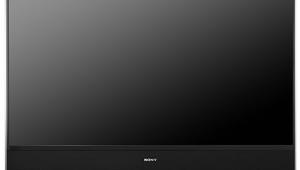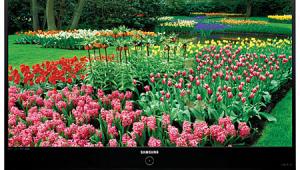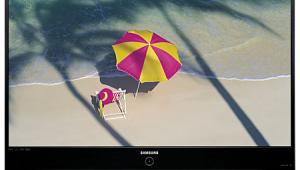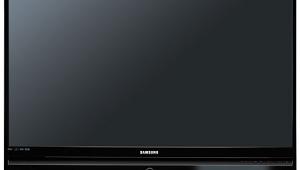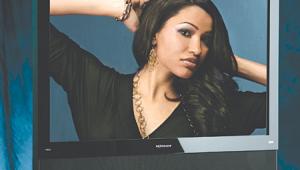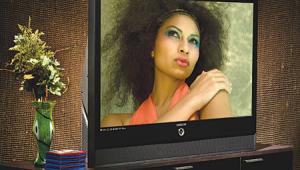Mitsubishi WD-65831 65" DLP Rear Projection TV
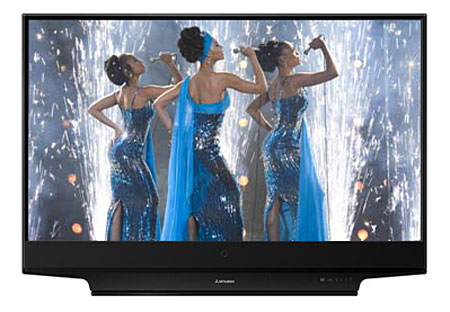
So here you have it: Mitsubishi's top-of-the-line DLP-based 1080p rear-projection TV. And still on hand for video battle: the JVC HD-61FN97 recently reviewed and raved about here, and a new Samsung HL-S6188W, the first place winner in a recent RPTV shootout at our sister publication, Home Theater. Both of these sets are referenced in this report. My full review of the Samsung will be posted here in the near future.
Comparing Mitsubishi Models
Upgrading from the base 731 series even to the 732, which costs only about $200 more, gives a huge jump in features and performance. Number one is the variable iris (called Dark Detailer), which dramatically improves blacks. TV Guide On-Screen is added (invaluable for CableCARD use), as is a memory card reader for displaying photos, and you get an additional component video input. Net Command gives you remarkable on-screen control of your whole AV system. The 732 series also includes Perfect Tint, which allows correcting (to a certain extent) the color accuracy of primary and secondary colors. Two other video enhancers, Sharp Edge and Deep Field Imager, are added as well and will be discussed later.
Six-segment color wheels are not uncommon in today's DLP sets. But these segments are, typically, just multiples of the primary colors: red, green, and blue (multiple segments of the same color help reduce rainbow artifacts). But the six-segment color wheels on all Mitsubishi DLP sets (except their current 73-inch models) have segments for not only the three primary colors, but for the three secondary colors as well. Mitsubishi claims that this results in an improvement in color brightness and accuracy.
So, what more does the additional $700 buy you in the Diamond Series? Not nearly as much as the $200 bought you in the 732 series, that's for sure. But you do get a high contrast screen for even better blacks and overall picture impact, a brighter 180-watt bulb, and a new and improved partially lit remote (excellent) with a second and simpler one included as well. Styling is also improved in the 831 series. Whether the internal circuitry is actually better in the Diamond sets is anyone's guess, but back in the days of the big CRT-based RPTVs, the Diamond versions always seemed to be a step up technically.
Firing It Up For The First Time
Operating a Mitsubishi is an experience very unlike any other. At first it might seem strange and almost baffling (the menus look very different—almost PC like), but with a bit of practice, you might well prefer it over all others. Thankfully, the owner's manual is among the best, since you'll need some guidance in order to use some of the more advanced features. Just getting it started, however, is a snap.
The inputs are auto-sensing. Plug a component in and the connection will appear. Only the inputs that are connected to a source are shown. Unlike the painfully slow JVC, switching among them is lightning fast.
The set initially comes on in Brilliant mode which, with its increased color saturation, is designed to jump off the showroom floor. But push the Video button on the remote and you'll find two better options: Bright (for a brightly lit room) and Natural (for a darker room). And not only has Mitsubishi given a complete setup memory for each input, but users can also set the brightness, contrast, and color temperature differently for each of these three modes. To the user, this means you can set up each source component to perfection. You never need to readjust the set when switching sources, and you can customize three different Day or Night modes for your own ambient light situation. Samsung and JVC should take note. These are valuable features that even the Sony SXRDs can't quite match. One note though: As you progress from Natural to Bright to Brilliant, color saturation (which you can't control separately) does increase slightly, giving a subtly more vivid rendition.
Mitsubishi got the default settings for all of the video controls nearly spot-on. Change color temperature to LOW (and remember to do it for each picture mode within each source) and you're over 90% there to a well-calibrated picture. I've seen a few Mits DLPs with a near perfect factory grayscale setup but even the worst I've seen (in LOW setting) was closer than most. The review sample was a bit reddish in LOW, though not terribly offensive, and way too bluish in HIGH. You can't get beautifully saturated secondary colors if you use the high color temperature setting, even though red, green, and blue might pop strongly.
With a good HD source, you'll likely be blown away by this set's bright, punchy picture and gorgeous, vivid colors. It's not your imagination. This set really can look spectacularly good with the right program material, even with factory settings.
This set is built for Blu-Ray and HD-DVD. Not only does it accept everything from 480i to 1080i via HDMI at 60Hz, it also accepts 1080p at 60, 30, or 24Hz. Even the computer input (DVI-I) can accept 1080p at these three refresh rates, making the 831 an ideal monitor for a home theater PC.
Not many sets can do 1080p/24. But although it will accept this resolution and frame rate, as far as I could determine the Mitsubishi cannot operate at multiples of 24Hz (the native rate of film) like 48 and 72Hz, which would effectively eliminate judder induced by 3/2 pulldown. But neither can any other RPTV we've tested. A bigger oversight is its inability to perform 3/2 pulldown compensation with 1080i HD sources, which causes some mild motion artifacts on HD movies. To be fair, 3/2 capability at 1080i is also still fairly unusual. 3/2 does work at 480i. Video noise reduction was the best I've seen and was remarkably effective in its higher settings.
- Log in or register to post comments



